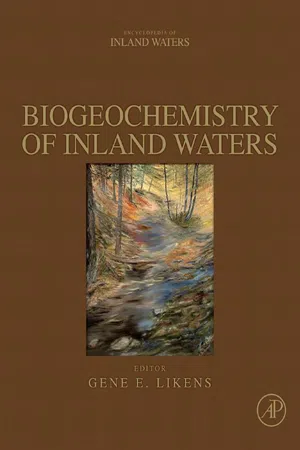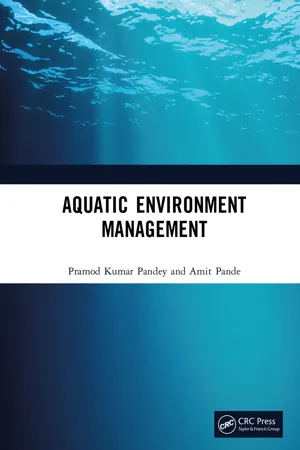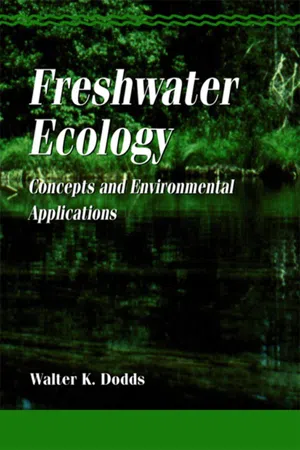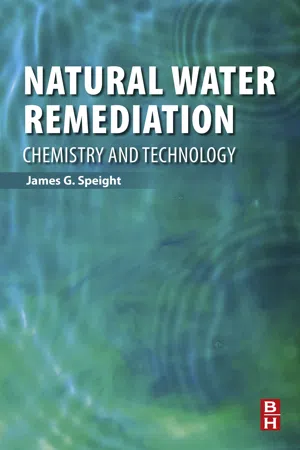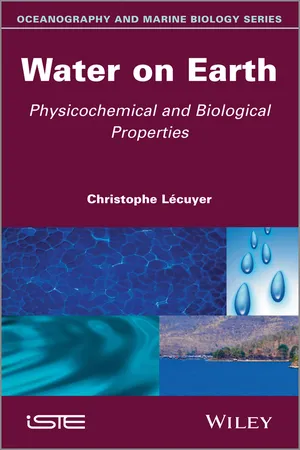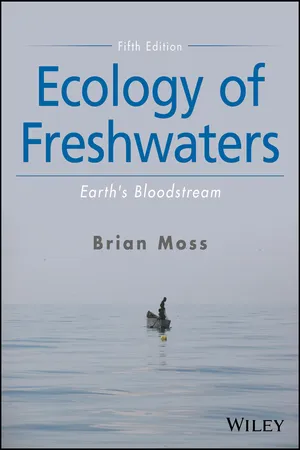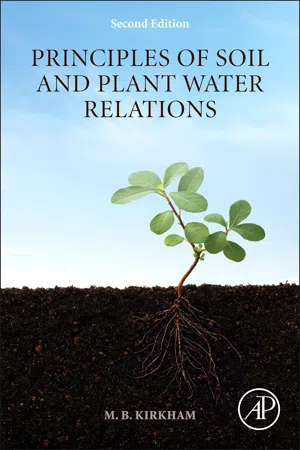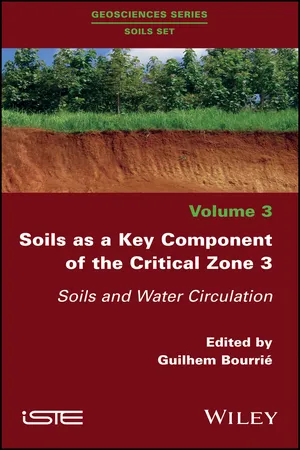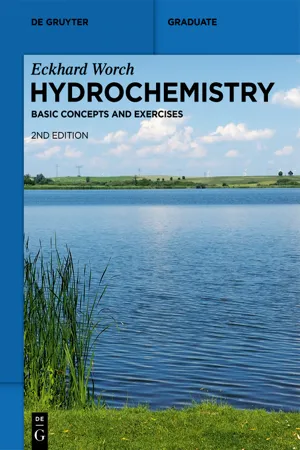Chemistry
Properties of Water
The properties of water include its high polarity, hydrogen bonding, and ability to act as a solvent. These properties contribute to water's high surface tension, cohesion, and adhesion, as well as its ability to moderate temperature changes. Additionally, water's unique properties make it essential for life and various chemical reactions.
Written by Perlego with AI-assistance
Related key terms
Related key terms
1 of 4
Related key terms
1 of 3
12 Key excerpts on "Properties of Water"
- eBook - ePub
- Gene E. Likens(Author)
- 2010(Publication Date)
- Academic Press(Publisher)
Properties of WaterPassage contains an image
Chemical Properties of Water
J.H. Aldstadt, III; H.A. Bootsma University of Wisconsin-Milwaukee, Milwaukee, WI, USAJ.L. Ammerman SEAL Analytical, Inc., Mequon Technology Center, Mequon, WI, USAWater is H2 O, hydrogen two parts, oxygen one, but there is also a third thing, that makes it water and nobody knows what it is.—D.H. Lawrence (1929)Introduction
Water is the most abundant molecule on Earth. In spite of being so common, water is quite unusual – from its high melting and boiling points to its tremendous solvating power, high surface tension, and the largest dielectric constant of any liquid. In this article, we present an overview of the chemical Properties of Water. The phrase ‘chemical property’ is context dependent, which we define in general as a description of the way that a substance changes its identity in the formation of other substances. A universally accepted set of chemical properties does not exist in the same way that there is, more or less, a standard set of physical properties for a given substance. Whereas a given substance has intrinsic physical properties (such as melting point), by our definition chemical properties are clearly tied to change. In addition to reactivity, a substance’s ‘chemical properties’ also typically include its electronegativity, ionization potential, preferred oxidation state(s), coordination behavior, and the types of bonding (e.g., ionic, covalent) in which it participates. Because these properties are extensively studied in general chemistry courses, we will not further discuss them here. Rather, we move beyond the basic general chemistry concepts and focus upon water in a limnologic context – particularly, its bulk fluid structure and aspects of its chemical reactivity in the hydrosphere.In the following pages, we begin by briefly reviewing the molecular structure of water and then discuss models for its structure in ‘bulk’ solution. We then turn our attention to the hydration of ions and an overview of important reactions that involve water, including acid–base, complexation, precipitation, and electron transfer. We conclude with a look at trends in the chemical composition of freshwater that are fundamental to the field of limnology. - eBook - ePub
- Pramod Kumar Pandey, Amit Pande(Authors)
- 2023(Publication Date)
- CRC Press(Publisher)
2 Physicochemical Properties of Water and Their Significance for Aquatic LifeDOI: 10.1201/9781003313137-22.1 Introduction
Water is the most abundant natural resource and covers a major portion of the Earth’s surface in the form of oceans, rivers, lakes, ponds, streams, swamps, wetlands, and glaciers. It is essential for all life, and all biotic and abiotic processes on the Earth depend on it. Chemically, one molecule of water is composed of two hydrogen atoms covalently bonded to a single oxygen atom (H2 O). Physically, it exists in all three states of matter, that is, liquid, solid, and gas. Water-based environments or aquatic ecosystems harbour the biosphere’s most diverse groups of animals and plants. The physicochemical Properties of Water have a fundamental relevance for aquatic biodiversity and the functioning of aquatic ecosystems (energy flow and nutrient cycling). The physical Properties of Water include temperature, turbidity, colour, salinity, total suspended solids, dissolved solids, and electrical conductivity. At the same time, the chemical Properties of Water include dissolved oxygen, carbon dioxide, pH, alkalinity, total hardness, ammonia, nitrite, nitrate, and phosphorous concentrations.These characteristics of water can directly impact aquatic organisms’ distribution, abundance, survival, and growth. They, thereby, can affect the balance of the ecosystem. For example, water temperature changes can affect the physiology of ectothermic fish and other aquatic organisms. Similarly, changes in pH and salinity can affect the ability of organisms to absorb nutrients/minerals and can lead to the death of some species. The abundance of dissolved oxygen and nutrients also plays an important role in the survival of aquatic organisms. Especially under captive conditions, oxygen sufficiency, suitable temperature, and concentration of metabolic waste products are key parameters that define optimal water quality ranges for the growth, well-being, and reproduction of aquatic organisms. Deviations from these ranges, whether too high or too low, can affect the body’s physiological processes. Therefore, monitoring water’s physical and chemical properties is essential for assessing the health of aquatic ecosystems and the organisms that inhabit the aquatic habitats. In the following sections of this chapter, we briefly discuss water’s key properties that affect aquatic life. - eBook - ePub
Freshwater Ecology
Concepts and Environmental Applications
- Walter K. Dodds(Author)
- 2002(Publication Date)
- Academic Press(Publisher)
2Properties of Water
Chemical and Physical Properties Relationships among Water Viscosity, Inertia, and Physical Parameters Movement of Water Forces That Move Water Summary Questions for ThoughtFIGURE 2.1 Water moving past an algal thallus at progressively higher velocities. Tracer particles allow visualization of turbulence. Velocities are 0.5 (A), 1.5 (B), 2 (C), and 3.5 cm s−1 (D)(from Hurd and Stevens, 1997 ; reproduced with permission of the Journal of Phycology ).Unique physical properties dictate how water acts as a solvent and how its density responds to temperature. These physical properties have strong biological implications and knowledge of water’s characteristics forms the foundation for aquatic science. The physical Properties of Water are so central to science that they form the basis of several systems of measurement, including mass, heat, viscosity, temperature, and conductivity. The Properties of Water influence how it changes geomorphology, conveys human waste, links terrestrial and aquatic habitats, and constrains evolution of organisms. In this chapter I explore how viscosity and inertia of water vary with scale, temperature, and relative velocity related to aquatic ecology. Movement of water is discussed in the last section, including how flowing water interacts with solid surfaces.CHEMICAL AND PHYSICAL PROPERTIES
One of the many unusual Properties of Water is that it exists in liquid form at the normal atmospheric temperatures and pressures encountered on the surface of Earth (Table 2.1 ). The majority of common compounds or elements take the form of gas or solid in our biosphere (exceptions include mercury and numerous organic compounds). The range of temperatures and pressures at which water occurs in a liquid state and additional distinguishing characteristics are related to polarity of the molecule and hydrogen bonding. The oxygen atom attracts electrons so the probability is greater that they will be nearer to the oxygen than the hydrogen atoms. Given the angle of attachment (104.5°) of the two hydrogen atoms to oxygen and a slight positive charge near the hydrogen atoms, the molecule exhibits polarity. The negative region near the oxygen attracts positive regions near the two hydrogen atoms resulting in hydrogen bonding (Fig. 2.2 ). Hydrogen bonding becomes more prevalent as water freezes but also occurs in the liquid phase (Luzar and Chandler, 1996 ;Liu et al., 1996); without hydrogen bonding, water would be a gas at room temperature. When water freezes, the molecules form tetrahedral aggregates that lead to decreased density. Thus, pure ice has a density of 0.917 g cm−3 - eBook - ePub
Natural Water Remediation
Chemistry and Technology
- James G. Speight(Author)
- 2019(Publication Date)
- Butterworth-Heinemann(Publisher)
The heat of vaporization of water is the highest known—as the molecules evaporate, the surface they evaporate from gets cooler (evaporative cooling) because the molecules with the highest kinetic energy are lost to evaporation. The process of evaporation in a closed container will proceed until there are as many molecules returning to the liquid as there are escaping. At this point the vapor is said to be saturated, and the pressure of that vapor (usually expressed in mm mercury) is the saturated vapor pressure.4.11 Viscosity
The viscosity of a fluid is the property of fluid that is a measure of the resistance to flow by the fluid. Liquids with stronger intermolecular interactions are usually more viscous than liquids with weak intermolecular interactions. Related to viscosity, cohesion is intermolecular forces between like molecules; this is why water molecules are able to hold themselves together in a drop. Water molecules are very cohesive because of the polarity of the molecule. Thus, water molecules stay in close proximity to each other (cohesion), due to the collective action of hydrogen bonds between water molecules. These hydrogen bonds are constantly breaking and new bonds being formed with different water molecules; but at any given time in a sample of liquid water, a large portion of the molecules are held together by such bonds.Water also has high adhesion properties because of its polar nature. On extremely clean/smooth glass, the water may form a thin film because the molecular forces between glass and water molecules (adhesive forces) are stronger than the cohesive forces. In order to dehydrate hydrophilic surfaces (i.e. to remove the strongly held layers of water of hydration) requires doing substantial work against these forces, called hydration forces. These forces are very large but decrease rapidly over a nanometer or less. They are important in biology, particularly when cells are dehydrated by exposure to dry atmospheres or to extracellular freezing.Most plants have adapted to take advantage of the adhesion Properties of Water that helps move water from the roots to the leaves (often referred to as capillary action). As an example, in the redwood tree (one of the tallest plants on Earth) water moves from the roots of the tree to the leaves, which can be a distance of two hundred feet or more. As a plant loses water through pores in the leaves, more water moves up from roots and stems to replace the lost water—the process of water loss by leaves is known as transpiration - eBook - ePub
Water on Earth
Physicochemical and Biological Properties
- Christophe Lécuyer(Author)
- 2013(Publication Date)
- Wiley-ISTE(Publisher)
Chapter 1
Water: A Molecule Endowed with Extraordinary Physicochemical Properties
1.1. Molecular geometry and electrical properties
A water molecule consists of an oxygen atom bonded to two hydrogen atoms. In water, each hydrogen atom is bound to the oxygen by a pair of electrons. However, only two of the six outer-shell electrons of oxygen are used to form covalent bonds, the remaining four being organized into two non-bonding pairs (Figure 1.1 ). The four electron pairs surrounding the oxygen tend to arrange themselves as far from each other as possible in order to minimize repulsions between these clouds of negative charge. However, the two non-bonding pairs exert a strong repulsion against the two covalent bonding pairs, which results in a deformed tetrahedral geometry with a angle of 105° instead of the theoretical angle of 109°. As a result, the H2 O molecule is electrically neutral even though the electrical charges are not distributed uniformly. Indeed, a negative charge is associated with the oxygen atom while the hydrogen atom carries a positive charge (Figure 1.2 ). This electronic configuration defines the polar structure of water molecules, which consequently have a mutual attraction and tend to stick together.This process is called “hydrogen bonding” and explains why water is a liquid instead of a gas under standard conditions (close to the Earth’s surface pressure and temperature conditions). In comparison to a covalent bond, the hydrogen bond is so weak that the timescale of its life expectancy is in the order of the picosecond (10−12 s), therefore explaining the low molecular viscosity of water ( - Mark Harvey(Author)
- 2015(Publication Date)
- Routledge(Publisher)
1 Properties of Water Dipping into water Properties and propertiesProperties of Water can mean many things: characteristics of water, physical, cultural, natural, or social, for example. Drinking water or spiritually cleansing water. Mountain spring water, or deep ocean water ‘untouched by human civilisation’, as one Taiwanese company bottling it bizarrely claimed. Swimming pool water or rice paddy field water. The water in Coca Cola or the water flushed down toilets. Tea or soup. Land or sea water.But ‘property’ can also refer to ownership: what kind of ownership and by whom? If the public owns it, what public? If the state, what water (rivers or groundwater aquifers) and on what scale within what territorial or cross-territorial boundaries? If a local community, by virtue of their ‘traditional’ collective proximity to a water resource? Moreover, is a proprietorial right legal or illegal, formal or informal, and, perhaps at least as significantly, are there proprietorial water voids: ambiguities, uncertainties or absences of rights to control a water resource?And then there are many ways of enquiring or knowing about water properties of all kinds: folk knowledge or natural scientific hydrology, market research or environmental science, anthropology or chemistry, urban planning or agronomy.Dipping into water, this book is an exploration of a particular kind into a particular kind of water: water for domestic consumption, primarily drinking. Initially, the springboard for the enquiry was the controversy surrounding the sustainability of bottled water, a rapidly expanding consumption habit and market in the United Kingdom, in relation to tapwater (Barlow and Clarke, 2002; Swiss Gas and Water Association, 2006; Botto, 2009; Gleick and Cooley, 2009; Gleick, 2010). In a modern developed urban society, the taken-for-granted ready availability of drinkable water flowing out of taps is only quite exceptionally undermined by droughts or burst mains. Yet, the very ordinariness of tapwater first needs to be seen in the perspective of how this urban tapwater went from extraordinary to ordinary – a process that took over a century and a half in the case of the United Kingdom. Second, its characteristic property of all-purpose water, for drinking, cooking, washing bodies and clothes, flushing toilets, gardening, again an historically manufactured property, must equally be seen for its very peculiarity. Tapwater has a doubly extraordinary ordinariness, always on tap, used for all domestic purposes. Not dedicated drinking water. That, you find in bottles.- eBook - ePub
Ecology of Freshwaters
Earth's Bloodstream
- Brian R. Moss(Author)
- 2018(Publication Date)
- Wiley(Publisher)
The consequences of these properties are important. The mean air temperature at the Earth’s surface is around 13.7 °C. Extremes of temperature run to well below the freezing point of water (0 °C) at the Poles and to well above it in the molten lavas that emerge when volcanoes erupt. The summer sun over the tropics can bring the soil temperature to 60–70 °C, painful to bare feet and perilously close to water’s boiling point of 100 °C. Both during a year and over longer periods such as glacial epochs, changes in temperature can readily shift water from its usable (to living organisms) liquid form to ice or vapour. Small changes in climate can lock enormous amounts away in polar glaciers or render moist regions arid. Small fluctuations in weather can mean that water supplies dry up or run amok as floods. Freshwater organisms, in the course of their evolutionary history, have had to cope with these uncertainties. Human societies, equally dependent on liquid water, face them continuously. Water is abundant on Earth, but mostly in unusable form for land and freshwater organisms, as ice, in deep groundwaters or, particularly, as the saline ocean. The usable supply of freshwater is small and vulnerable.There is more. Water is densest not at its freezing point but at nearly 4 °C above it, so that water bodies freeze from the surface (Fig. 4.1 ), insulating the water underneath from further cooling and generally always leaving liquid water for living organisms beneath the ice. Water also dissolves a huge range of other compounds, making it the near universal solvent that is needed for a biochemical medium; it has a high specific heat, changing temperature relatively slowly, and buffering temperature extremes for organisms living in it; it has a high viscosity, making it a ‘sticky’ medium for organisms; and its surfaces have a skin, a surface tension. All of these properties have effects on living organisms and depend on the peculiar molecular structure of water.(Photograph by Randy T (Randylikestoclimb).)Ice floats on water because the water molecules of its crystal structure are more distantly spaced than those in liquid water at the same temperature and up to around 4 °C. Lakes thus freeze from the surface downwards.Figure 4.14.2 The molecular Properties of Water and their physical consequences
Water has two hydrogen atoms and one oxygen atom, the hydrogens held at nearly 0.1 nm from the oxygen, jointly making an angle of 104° 27′ with it. Six electrons in the outer orbit of the oxygen are shared with one from each of the hydrogens to give the eight that complete the outer shell of oxygen; two from oxygen are shared to complete the outer shell of the hydrogens. If that were all there was to it, water would be an unremarkable covalent compound and a gas at Earth temperatures. There would be no life on Earth, no ocean, no ice caps, simply a very hot, completely dry, rocky waste. - eBook - ePub
- M.B. Kirkham(Author)
- 2014(Publication Date)
- Academic Press(Publisher)
Chapter 3Structure and Properties of Water
Abstract
This chapter presents the structure of the water molecule and shows its tetrahedral charge structure. Two forces that bind water molecules together are given: hydrogen bonding and the van der Waals–London force. Fifteen physical Properties of Water are discussed: specific heat; heat of vaporization; heat of fusion; heat (thermal) conduction; transparency to visible radiation; opaqueness to infrared radiation; surface tension; density; expansion upon freezing; ionization; dielectric constant; solvent for electrolytes; solvent for nonelectrolytes; adsorption; and viscosity. A table is presented that shows values for six different physical Properties of Water at different temperatures, and they are density, surface tension, viscosity, heat of vaporization, specific heat, and thermal conductivity. It is pointed out that life depends upon water, and, if life exists on other planets, water is probably present. A biography of van der Waals is given in the appendix.Keywords
Density ; Heat of vaporization ; Hydrogen bonding ; Specific heat ; Surface tension ; Thermal conductivity ; van der Waals force ; Viscosity ; Water molecule3.1 .Structure of WaterTo understand the nature of water in soil and plants, we need a mental picture of the water molecule. The water molecule (Figure 3.1 ) is composed of two hydrogen atoms and one oxygen atom. The water molecule is positively charged on one side and negatively charged on the other and is, thus, a dipole. Two hydrogen atoms each share a pair of electrons with a single oxygen atom. The two hydrogen atoms of the water molecule are separated at an angle of 103–106°, measured with the oxygen atom as the apex of the angle and with the two hydrogen protons as points on the angle sides. The electron pairs shared between the oxygen nucleus and the two hydrogen protons only partially screen (neutralize) the positive charge of the protons. The result is that the proton side of the molecule becomes the positive side of the water molecule (Kirkham and Powers, 1972, p. 2 - eBook - ePub
- Des W. Connell(Author)
- 2005(Publication Date)
- CRC Press(Publisher)
Part IIBasic Properties of Chemicals in the EnvironmentPassage contains an image
2 Bonds and Molecules: Their Influence on Physical-Chemical Properties in the Environment
2.1 INTRODUCTIONThe behavior of chemicals in the environment is governed by their physical-chemical properties as well as transformation and degradation processes, which are discussed in Chapter 3 . The physical-chemical properties of compounds include such characteristics as boiling point (bp), melting point (mp), solubility in water, and similar properties. These properties are, in fact, measurements made in the laboratory of environmentally relevant characteristics. For example, compounds with low boiling points evaporate rapidly into the atmosphere, whereas compounds that are highly soluble in water disperse readily in streams and rivers. Thus, an understanding of these properties would be expected to give a clearer perception of how compounds will behave in the environment. This means that the measurement of the physical-chemical properties of a compound could be used to provide an evaluation of its environmental distribution in air, water, sediments, soil, and animals.2.2 STATES OF MATTER IN THE ENVIRONMENTA cursory examination of the nature of our environment reveals that matter exists in basically three states: solid, liquid, and gas. Solids are present as soil, rocks, and so on, whereas liquids are represented by the great water bodies of the oceans, lakes, and rivers. The gaseous component of the environment is the atmosphere. These states exercise a basic influence on the nature and distribution of all substances, both natural and man-made, in the environment in basic chemical terms. Solids have a definite volume and shape and consist of large numbers of particles that could be atoms, ions, or molecules (Figure 2.1 - eBook - ePub
- Eckhard Worch(Author)
- 2015(Publication Date)
- De Gruyter(Publisher)
2 O molecules (cluster model). Although such a simple model can explain some of the unique Properties of Water, nowadays more sophisticated continuum models are preferred that are in better accordance with X-ray and neutron scattering experiments and with computer simulations. Following these models, water can be considered a dynamic macromolecular less-ordered hydrogen-bonded network in which the average coordination number of a water molecule is 4. In contrast to the fixed ice structure, a stronger bending of bonds is possible.The change of the water structure during temperature increase and phase transformation can be interpreted as a transition from a long-range order in the ice crystal over a pronounced short-range order in the liquid water toward the existence of mainly isolated molecules in the gas state. As we will see in the following section, the occurrence of hydrogen bonds explains a number of exceptional Properties of Water.2.2 Properties of Water
2.2.1 Density
The density, p, is defined as the ratio of mass, m, and volume, V :(2.1)The density of ice and water depends on the temperature as shown in Figure 2.6 . Ice has an open structure (see Figure 2.5 ) that explains its relatively low density. In contrast to most other solids, ice shows a volume contraction during melting. This can be explained with partial collapsing of the bulky ice structure where some of the bonds are broken or bended. The density of the liquid water at 0 °C (0.9998 g/cm3 ) is about 9% higher than that of ice at the same temperature (0.9166 g/cm3 ). Accordingly, freezing of water leads to a volume expansion. In closed spaces where the volume cannot expand, the pressure strongly increases, often to a value where the walls of the closed space are destroyed. This effect explains, for instance, the alteration of porous rocks or other porous materials in winter, when the water in the pores freezes.Liquid water shows a density maximum at about 4 °C (exactly 3.98 °C). The occurrence of a density maximum is a specific property of water and not observed for other liquids. It is therefore referred to as density anomaly of water. Typically, the volume of a liquid increases with increasing temperature, due to the volume expansion caused - eBook - ePub
Soils as a Key Component of the Critical Zone 3
Soils and Water Circulation
- Guilhem Bourrié, Guilhem Bourrié(Authors)
- 2018(Publication Date)
- Wiley-ISTE(Publisher)
1.1. The “abnormal” Properties of Water Water has “abnormal” properties compared to other liquids [Car92]:- – H2 O is liquid under standard conditions (STP: 25°C, 1 bar), whereas H2 S is gaseous, although O is lighter than S;
- – ice Ih is less dense than liquid. Otherwise, during the glaciations, a continuous layer of ice would have settled at the bottom of the ocean and would have never thawed. The specific gravity of H2 O( l .) passes through a maximum at 3.984°C;
- – the compressibility coefficient passes through a minimum at 46.5°C;
- – heat capacity passes through a minimum at 37.5°C;
- – sound velocity passes through a maximum around 70°C;
- – viscosity is very high and passes through a minimum when the pressure rises;
- – the surface tension and the dielectric constant ϵ are both very high and decrease with the temperature;
- – the phase diagram of water is very complex, with at least 15 varieties of ice, including two amorphous ones.
Many properties (73!) thus show non-monotonic, nonlinear variations with T and P, but extremums are observed for different values of P and T depending on the quantity under consideration. Some Properties of Water are presented in Table 1.2 . The enthalpy of fusion of ice I at 0°C is close to 6 kJ mol− 1 , and the enthalpy of vaporization of liquid water at 100°C is close to 41 kJ mol− 1 .Values of the specific volume, the enthalpy and the dielectric constant of water at 0°C, 100°C and 1 bar and at the critical point (see Chaplin, Martin “Water structure and science”, www1.lsbu.ac.uk/water and the several references cited)Table 1.2.Property Pressure (bar) Temperature (°C) Value Vs (ice Ih ) (dm3 kg− 1 ) 1 0 1.091 Vs (liquid) (dm3 kg− 1 ) 1 0 1.000132 Vs (liquid) (dm3 kg− 1 ) 220.64 373.946 3.1055 ΔH⦵ fusion (kJ mol− 1 - eBook - ePub
Hydrochemistry
Basic Concepts and Exercises
- Eckhard Worch(Author)
- 2023(Publication Date)
- De Gruyter(Publisher)
2 O molecules (cluster model). Although such a simple model can explain some of the unique Properties of Water, nowadays more sophisticated continuum models that are in better accordance with X-ray and neutron scattering experiments and with computer simulations are preferred. Following these models, water can be considered a dynamic macromolecular less-ordered hydrogen-bonded network in which the average coordination number of a water molecule is 4. In contrast to the fixed ice structure, a stronger bending of bonds is possible.The change of the water structure during temperature increase and phase transformation can be interpreted as a transition from a long-range order in the ice crystal over a pronounced short-range order in the liquid water toward the existence of mainly isolated molecules in the gas state. As we will see in the following section, the occurrence of hydrogen bonds explains a number of exceptional Properties of Water.2.2 Properties of Water
2.2.1 Density
The density, ρ, is defined as the ratio of mass, m, and volume, V:(2.1)ρ =m VThe density of ice and water depends on the temperature as shown in Figure 2.6 . Ice has an open structure (see Figure 2.5 ), which explains its relatively low density. In contrast to most other solids, ice shows a volume contraction during melting. This can be explained with partial collapsing of the bulky ice structure where some of the bonds are broken or bended. The density of the liquid water at 0 °C (0.9998 g/cm3 ) is about 9% higher than that of ice at the same temperature (0.9166 g/cm3 ). Accordingly, freezing of water leads to a volume expansion. In closed spaces where the volume cannot expand, the pressure strongly increases, often to a value where the walls of the closed space are destroyed. This effect explains, for instance, the alteration of porous rocks or other porous materials in winter, when the water in the pores freezes.Figure 2.6: Density of ice and water as a function of temperature.Liquid water shows a density maximum at about 4 °C (exactly 3.98 °C). The occurrence of a density maximum is a specific property of water and not observed for other liquids. It is therefore referred to as density anomaly of water. Typically, the volume of a liquid increases with increasing temperature, due to the volume expansion caused by increasing molecular motion. The density maximum observed in the case of water is the result of two opposing effects. At low temperatures, the collapsing of the residual ice structures with the related volume contraction (density increase) dominates the overall effect, whereas at temperatures higher than 4 °C the common volume expansion of liquids dominates.
Index pages curate the most relevant extracts from our library of academic textbooks. They’ve been created using an in-house natural language model (NLM), each adding context and meaning to key research topics.
Explore more topic indexes
Explore more topic indexes
1 of 6
Explore more topic indexes
1 of 4
